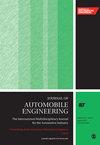大型高净空自走式喷雾器自动导航控制系统的设计与验证
IF 1.5
4区 工程技术
Q3 ENGINEERING, MECHANICAL
Proceedings of the Institution of Mechanical Engineers Part D-Journal of Automobile Engineering
Pub Date : 2024-09-14
DOI:10.1177/09544070241280403
引用次数: 0
摘要
开发了一种自动导航系统,旨在提高大型高净空自走式喷雾器的精度和效率。首先,根据喷雾器的结构特点和操作要求设计了导航液压转向系统,并建立了系统数学模型来描述导航系统的工作特性。该系统包括导航控制策略、纯追求路径跟踪算法和模糊自适应比例-积分-派生控制方法。为了验证系统的性能,使用 MATLAB/Simulink 开发了一个仿真模型,并比较了各种控制方法的性能。此外,还以课题组自主研发的 3WPG-3000 型高净空自走式喷雾器为基础,搭建了实车试验平台。仿真结果表明,在两轮转向模式下,车辆的横向位置偏差在 11 s 内减小到 0 m,航向角偏差在约 11 s 内减小到 0 rad;而在四轮转向模式下,车辆的横向位置偏差在 8 s 内减小到 0 m,航向角偏差在 8 s 内减小到 0 rad。实地测试结果表明,在 3 km/h 的速度下,喷雾器在两轮转向模式下 5.84 s 内跟踪目标路径并达到稳定,在四轮转向模式下 4.08 s 内跟踪目标路径并达到稳定;而在 5 km/h 的速度下,喷雾器在四轮转向模式下 3.75 s 内跟踪目标路径并达到稳定。总之,模拟和实地测试的结果验证了该系统的稳定性、准确性和实用性。本文章由计算机程序翻译,如有差异,请以英文原文为准。
Design and verification of automatic navigation control system for large high clearance self-propelled sprayer
An automatic navigation system aiming at improving the accuracy and efficiency of a large high clearance self-propelled sprayer was developed. First, a navigation hydraulic steering system was designed according to the structural characteristics and operation requirements of the sprayer, and a mathematical model of the system was established to describe the working characteristics of the navigation system. The system includes a navigation control strategy, a pure pursuit path tracking algorithm, and a fuzzy adaptive proportional-integral-derivative control method. To verify the performance of the system, a simulation model was developed using MATLAB/Simulink, and the performance of the control methods were compared. Additionally, an actual vehicle test platform was built based on 3WPG-3000 high clearance self-propelled sprayer independently developed by the research group. The simulation results revealed that under the two-wheel steering mode, the lateral position deviation of the vehicle decreases to 0 m in 11 s, and the heading angle deviation decreases to 0 rad in about 11 s; while under four-wheel steering mode, the lateral position deviation of the vehicle decreases to 0 m in 8 s, and the heading angle deviation decreases to 0 rad in 8 s. The field test results revealed that at the speed of 3 km/h, the sprayer tracked the target path in 5.84 s under the two-wheel steering mode and reached stability, and tracked the target path in 4.08 s under the four-wheel steering mode and reached stability; while at the speed of 5 km/h, the spray tracked the target path in 3.75 s under the four-wheel steering mode and reached stability. Altogether, the results of the simulation and field test verify the stability, accuracy, and practicability of the system.
求助全文
通过发布文献求助,成功后即可免费获取论文全文。
去求助
来源期刊

CiteScore
4.40
自引率
17.60%
发文量
263
审稿时长
3.5 months
期刊介绍:
The Journal of Automobile Engineering is an established, high quality multi-disciplinary journal which publishes the very best peer-reviewed science and engineering in the field.
 求助内容:
求助内容: 应助结果提醒方式:
应助结果提醒方式:


